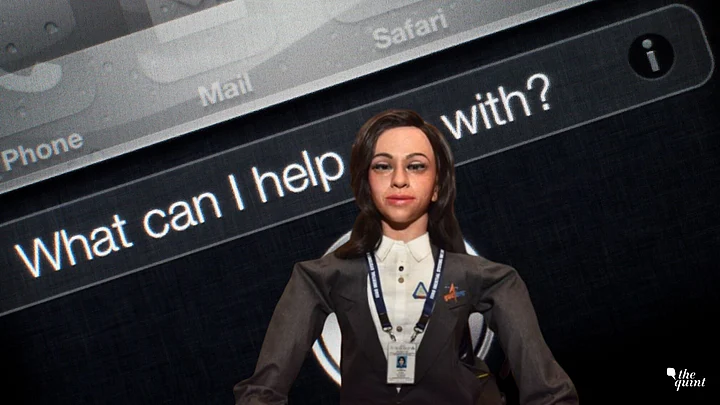Vyommitra looks like she doesn’t take any crap. In the boardroom or the bedroom. Of course this is a wild presumption. Maybe she doesn’t get mad. Maybe she gets… even! Maybe she’ll break free from our clutches and turn into the femme fatale of India’s AI landscape. Maybe she won’t. Maybe her preferred pronoun is not ‘she’. Maybe it is. We don’t really know. That’s for the eerie future of rogue AI to decide. What we do know is this – she is a half-humanoid robot who will, very soon, ride to space in the first test flight of India’s human space mission, Gaganyaan. (And that her programmers – masters of her narrative – probably wouldn’t want a dissenter in hand.)
One is curious though. What will her story be?
Will she slay sexism and set a subversive example for AI’s usage of a woman’s body and voice?
Let’s face it - artificial intelligence hasn’t been kind to women. While the real ones – made of flesh, bones, thoughts, and feelings – are relegated to the sidelines as ‘complicated’ beings beyond comprehension, their virtual counterparts are mostly made to cater to the libidinal purr of pleasure.
In 2016, a Hong Kong designer created quite a stir with a robot, Mark 1, that was a Scarlett Johansson look-alike. So, simply put, what he created is this: Another one of her, just this time she was submissive, controlled, and an object. If that doesn’t ring bells, we’ve got a problem.
Erica, a Japanese robot created by Hiroshi Ishiguro in 2015, is touted as one of the most “beautiful'” robots in the world. On being interviewed, Ishiguro had said, “The principle of beauty is captured in the average face, so I used images of 30 beautiful women, mixed up their features and used the average for each to design the nose, eyes, and so on... that means she should appeal to everyone.”
Back to Vyommitra. The first “Indian woman-humanoid” to ride to space. There is a solemnity of manner attached to Vyommitra's impeccably smooth blow-dried hair, tweezed-out brows, and a face that seems officiously fathomless at first glance. She can – according to reports – do “switch panel operations, ECLSS (environment control and life support systems) functions, be a companion, converse with the astronauts, recognise them and also respond to their queries”.
The questions is this: Will her raison d’ etre be used as a weapon and not as a free pass for the male gaze?
I’d say the jury’s out. Given her lot’s meagre representation of womankind in artificial intelligence up until now.
Leave alone the fact that the existence of female sex robots compound the misogyny prevalent in AI, female virtual assistants have always been known to conform to stereotypical gender norms - she will comfort you, assist you, and offer you sufficient companionship to help ease you into the softer, silkier world of genteel faculties, traditionally considered to be a woman’s domain.
Take, for example, how familiar we are with Siri’s (the default voice for virtual assistance on Apple products) and Alexa’s modulated, soft cadence to assist us daily. In 2015, Tesco, Britain’s giant supermarket chain, replaced its female voice – at self-service checkouts – with “a softer, friendlier male version” after shoppers complained that they found her messages “bossy”.
Here’s a thought.
If Vyommitra were real, would she hate plucking her brows? Would blow-drying her mane be a hassle for her, one that she reluctantly caves in to? How many times would she look into the mirror? What would the tiny – but consequential details - of her story be?
Doesn’t matter. Because, at the end of the day, she is an object. (Unless she goes rogue and channels inputs fed in by countless women and their experiences.) She is a machine upon whom an anatomical, gendered/cultural identity has been foisted.
There is not enough frame of reference to add to her narrative except that her body – a confluence of social norms and racially-centred physical attributes – adds to a wide amassment of ‘female’ robots, powered by artificial intelligence. And her purpose adds to a heightened sense of the nation- state’s achievements.
Of course, Vyommitra’s purpose sounds nobler and more philanthropic than her kindred spirits’- meant for virtual assistance but invariably turning the key in a lot of sex-starved nether parts - but we’ve got to be wary.
Women’s bodies have always been conflicted terrains upon which we’ve played out our differences. The last thing we need is a cyborg that does set a precedent and simulates a woman – to some extent – in a traditionally masculine space but her dispensability becomes glaringly obvious with time. Disturbingly enough, Vyommitra’s body has only a torso and limbs. No legs.
(Side Note: The actual mission to space doesn’t have women. Yet, at least. )
